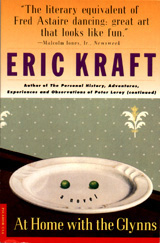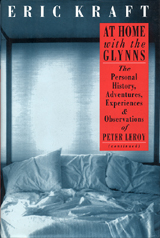
YOU CAN READ
THE FIRST HALF OF
THE BOOK
(21 CHAPTERS)
HERE,
ONLINE,
OR,
FOR MAXIMUM PORTABILITY
AND CONVENIENCE
WHEN READING
ON THE BEACH
OR
IN THE TUB,
YOU CAN BUY THE
PICADOR USA
PAPERBACK EDITION AT
AMAZON.COM
OR
BARNES&NOBLE.COM
OR
YOU CAN DOWNLOAD
THE COMPLETE TEXT
AS AN
eBOOK
AND
READ IT ON A PDA.

|
Chapter 14
Meeting Mr. Glynn
 HE
CARRIAGE HOUSE, the Glynns’ home, had a roof of imbricate tile, like the
mansion itself. The walls were made of stone, like those of the mansion.
A stone building was an extraordinary thing in Babbington, for the town
lay in the alluvial plain laid down by an ancient glacier, a plain of fine
grains, silt, and sand. There were no sizable rocks anywhere nearby.
To build in stone meant hauling the stone from a great distance, at great
expense of money or labor, or both. When my grandfather Leroy built
the stone chimney and fireplace of his house, he hauled the stones, five
or six at a time, in a flivver. The builders of the Glynn carriage
house—and, of course, the mansion to which it was subordinate—had the advantage
of buying the services of a carter, but still the feat and the audacity
of the decision that underlay it were impressive. It made the carriage
house and mansion eccentric buildings from the bottom up. A stone
building spoke of stability and endurance, but a stone building built on
sand—“built on sand,” the very metaphor of impermanence—was a folly.
Babbingtonians must have had their sense of the rightness of things confirmed
when the Glynns moved into the carriage house. It was the perfect
place for such eccentrics to live, the only place in town that would have
suited them. HE
CARRIAGE HOUSE, the Glynns’ home, had a roof of imbricate tile, like the
mansion itself. The walls were made of stone, like those of the mansion.
A stone building was an extraordinary thing in Babbington, for the town
lay in the alluvial plain laid down by an ancient glacier, a plain of fine
grains, silt, and sand. There were no sizable rocks anywhere nearby.
To build in stone meant hauling the stone from a great distance, at great
expense of money or labor, or both. When my grandfather Leroy built
the stone chimney and fireplace of his house, he hauled the stones, five
or six at a time, in a flivver. The builders of the Glynn carriage
house—and, of course, the mansion to which it was subordinate—had the advantage
of buying the services of a carter, but still the feat and the audacity
of the decision that underlay it were impressive. It made the carriage
house and mansion eccentric buildings from the bottom up. A stone
building spoke of stability and endurance, but a stone building built on
sand—“built on sand,” the very metaphor of impermanence—was a folly.
Babbingtonians must have had their sense of the rightness of things confirmed
when the Glynns moved into the carriage house. It was the perfect
place for such eccentrics to live, the only place in town that would have
suited them.
The building was in three parts, symmetrically balanced.
The center had once been open, a porte cochere through which the horses
were led to the courtyard in the back. On either side, there had
been space for carriages and the horse stalls, and above them had been
living quarters for the grooms and other outdoor staff, gardeners and drivers.
The Glynns had their living room in the center part, which they had enclosed
mostly with glass—small leaded panes set into large wooden frames.
Set in the center of all that glass was a massive wooden door. I
knocked on it.
Margot and Martha came running. They flung
the door open and tugged me inside.
“Where have you been, Peter?” asked Margot.
“It’s getting late!”
“What kept you?” asked Martha.
“I was just—thinking,” I said.
“Thinking?” she cried. “Can’t you think
and walk at the same time?”
“Oh, sure,” I said, chuckling. “I mean I stopped
in front of the Nevsky mansion, and I got to thinking about the night the
mansion burned—”
“You weren’t even born,” Margot pointed out.
“Oh, no. Of course. But still I—”
“Snap out of it, Peter,” said Martha. She
put her hand on my brow, as if checking to see if I had a fever.
“It’s time to beard the lion,” said Margot.
She grabbed me by the sleeve and pulled me toward
the room on the left. Martha pushed. I was surprised to discover,
as I shuffled along under their tugging and prodding, that I was nervous
about speaking to their father. In fact, I became more and more uneasy
with each step. I began to drag my feet.
“What’s the matter with you?” asked Martha.
“I don’t know,” I said. “My legs are getting
kind of shaky—”
“You’re not going to chicken out?”
“No—I—at least I don’t think so.”
“Your hands are getting sweaty.”
“Yeah,” I said. “Could we wait a minute?”
“No!” said Margot. “We’re late already!”
With a last effort, they shoved me through the door
of Mr. Glynn’s studio. The studio filled the entire leftward third
of the carriage house, the part that had been horse stalls. It was
now one large room, open to the roof. It felt cavernous. Across
the beams that had supported the hayloft Mr. Glynn had laid narrow catwalks
that allowed him to reach the tops of his largest canvases. He was
up there now, grumbling and snorting and wiping at a canvas with a rag.
The painting he was working on was impossible to take in as a single piece
from where I was standing. It was two stories tall and must have
been forty feet wide. Seen from below, even at such a distance, Mr.
Glynn was an imposing figure: a huge pair of shoe soles, three spherical
body components (one belly, two buttocks), two cavernous nostrils, and
fronds of gray hair. He seemed to be wearing a brown leather apron,
something like a blacksmith’s getup.
“Dad!” called Margot.
Mr. Glynn said, apparently, “Sedigidup.”
“Dad, Peter’s here,” said Martha.
“Sedigidup!”
“Daaad,” said Martha.
“Send the kid up!” he bellowed.
Margot pointed to a ladder, a jerry-built and flimsy
thing, standing away from the comforting solidity of the stone walls, leaning
against nothing more than one of the narrow catwalks above. I knew
what I had to do: mount the ladder, climb up, make my way across the rickety
boards to Mr. Glynn’s side, and make conversation with him. I had
to try to win him over. I had to do this for Margot and Martha, my
friends. I started up the ladder. Climbing it, with the ladder
flexing and swaying every time I moved up a rung, I was able at last to
put my finger on the uneasiness I had felt from the moment I had entered
the Glynns’: I felt like Jack, in “Jack and the Beanstalk.” Now I
was climbing the beanstalk. In a moment I was going to have to confront
the giant and try to put something over on him, trick him, pull the wool
over his eyes. Why am I thinking that? I wondered. I don’t
have anything to hide. There’s nothing up my sleeve. Why do
I feel so dishonest?
I reached the catwalk, stood there a moment congratulating
myself, and looked down at the girls. Martha put her hands together
and shook them beside her head to congratulate me, but Margot was making
a waving motion and pointing to her wrist, as if there were a watch there,
urging me on. I made my way, with a tightrope walker’s mincing steps,
to Mr. Glynn’s side.
He had put the rag aside and was working at the
canvas with a roller. I knew no other artists, so I didn’t know how
to talk to him, what style to use, what approach to take, but the sight
of the roller encouraged me some, since I had a little experience painting
with a roller. I had helped my parents paint my room. Most
of my work had been confined to cleaning up, it’s true, but still I thought
I saw a useful opening, or, more accurately, a small overlap in our lives
and our selves (the kind of overlap that my friend Mark Dorset, the psycho-sociologist,
has illustrated so tellingly in the modifications of Venn diagrams that
he calls Dorset diagrams), and so I felt that I could talk to Mr. Glynn.
“I see you use a roller,” I said—ingratiatingly,
I hoped.
“Among other implements,” he said, and he cleared
his throat, or, perhaps, growled.
“Uh-huh,” I said, and then added, with a modest
shrug: “I’ve used a roller myself. Now and then.” As soon as
I said it, the thought occurred to me that Mr. Glynn might have begun his
career by helping his parents paint his bedroom.
“Umph,” he said. He made a face as if he’d
smelled something odd and unpleasant. The giant, I recalled, was
exceptionally good at smelling a rat.
“You can cover a large area pretty fast with a roller,”
I said, quoting the clerk at the paint store who had talked my father out
of painting with brushes. I was by now quite taken with the notion
that maybe I had taken the first step on my way to becoming an artist myself
that bedroom-painting afternoon, while I was grumbling my way through the
cleaning of the rollers. It was an exciting thought, all the more
exciting for having come to me entirely unexpectedly.
“Umph,” he said again. I wasn’t making much
progress. I tried to bring to mind some more of my roller experiences,
but they didn’t go much further than cleaning the damned things.
“They’re hard to clean,” I said after an awkward interval.
He turned and looked at me. I was grinning
with the pleasure of the notion that I was well on my way to becoming a
painter myself, a picture painter, not a bedroom painter.
“I don’t bother anymore,” he said with a wink.
“You mean you just throw them out?” I asked.
“Yeah.”
“Wow,” I said.
This was my first introduction to the devil-may-care
attitude of artists. I was powerfully attracted to it immediately.
“Here,” he said, holding the roller out toward me.
“Draw your favorite animal.”
I knew what this was. It was a test.
I knew from fairy tales that small boys like me in situations like this
were always being required to pass tests in order to win the companionship
of maidens or escape the wrath of enormous men in leathern garb like aprons
or buskins. I felt confident for a moment, simply because I understood
in the broadest terms what situation I was in, but then, holding the roller,
looking at the canvas, I realized that none of the details were familiar.
The notion of using a roller to make a picture of something had never occurred
to me. Suddenly a roller seemed the wrong tool for the job.
Everything I’d learned during the painting of my room was going to be useless
in this test. I stalled while I tried the heft of the roller, thought
about what I might draw.
“Is this the only color you use—black?” I asked.
“It’s charcoal gray,” he corrected me. “And
no, it’s not the only color. If you look closely at each of my paintings,
you’ll find a little bit of pink in it somewhere.”
“Aha!” I said. “I thought so.”
Again, he made the look of a giant smelling a rat.
“We’ll never see the movie if we don’t get going!”
called Margot.
“Be right there,” I called, and then realized that
I was being presumptuous. I still had to pass the test: I still had
to draw my favorite animal. I made a swipe at the canvas with the
roller. It left a low arch of charcoal gray.
“Hm,” said Mr. Glynn.
I made another swipe and left an inverted arch under
the first. Then I held the roller with both hands, like a broadsword,
and dragged it horizontally, so that it didn’t roll at all, but left a
thinner line between the two arches.
“Ah!” said Mr. Glynn. I think he liked my
technique. He looked at what I’d done. He looked at me.
He looked at my painting again. He stepped back from it, to the limit
of the planking. He moved to the left. He moved to the right.
He rubbed his nose. “What is it?” he asked.
“A clam,” I said.
“A clam? That’s your favorite animal?”
“Yeah.”
“Why?”
“Well, they don’t bite, for one thing.”
“Peeeterrrr!” called Margot, from far below.
“And,” said Mr. Glynn, with the raised eyebrow that,
it seemed to me, he probably used to indicate an attitude of easy familiarity
with his artist colleagues, “they’re easy to draw.”
“Yes, sir,” said I. I handed him the roller.
“You want to take my daughters to the movies,” he
said.
“Um—they want me to take them to the movies,” I
said. Then I immediately corrected myself. “Walk them
to the movies.” He seemed not to understand the distinction, so I
added, “I’m not going to pay.”
“Oh,” he said, “I see,” and he burst out laughing.
“Daaaady!” cried both girls. “Can’t we
go
now?”
“I’m afraid not,” said Mr. Glynn.
To this day, I cannot relive the moment of his saying
that without a crushing feeling of defeat. I looked at my painting
of a clam. Was it that bad—so bad that I wasn’t qualified to walk
his daughters to the movies?
“I’m not going to let my daughters go to the movies
with a strange boy,” he called, and he shrugged.
“He’s not that strange!” shouted Martha.
“You know what I mean,” said Mr. Glynn. He
gave me what I accepted as an apologetic look.
“Then let us go alone!” wailed Margot.
“We’ve been through all that,” said Mr. Glynn.
He turned to me. “When you grow up, you’ll understand,” he asserted.
“A father likes to get to know a fellow before he’ll let him take his girls
to the movies.”
“Walk,” I said.
“Yeah, well, even before he’ll let a fellow
walk
his girls to the movies.”
“Okay,” I said. I headed for the ladder.
There was probably still time to catch most of Duel in the Dust,
after all. Mr. Glynn followed me to the ladder and laid a hand on
my shoulder before I began climbing down.
“Peter?” he said, almost in a whisper.
“Yeah?”
“Why don’t you come back and see me tomorrow?
We can start getting to know each other.”
“Okay,” I said, and felt my heart leap up.
Perhaps the fault lay only in my strangeness and not in my clam.
“Maybe I can teach you how to draw,” he added.
“Sure,” I said.
I descended the ladder with my head down, so that
I wouldn’t have to look at my defective attempt.
“Nice try, Peter,” Martha said when we were at the
door.
“I think it was the middle part,” I said.
“Huh?” said Margot.
“The line where the two shells join,” I explained.
“It should have been—I don’t know—different—better.”
|

|



 Here
are a couple of swell ideas from Eric Kraft's vivacious publicist, Candi
Lee Manning:
Here
are a couple of swell ideas from Eric Kraft's vivacious publicist, Candi
Lee Manning: